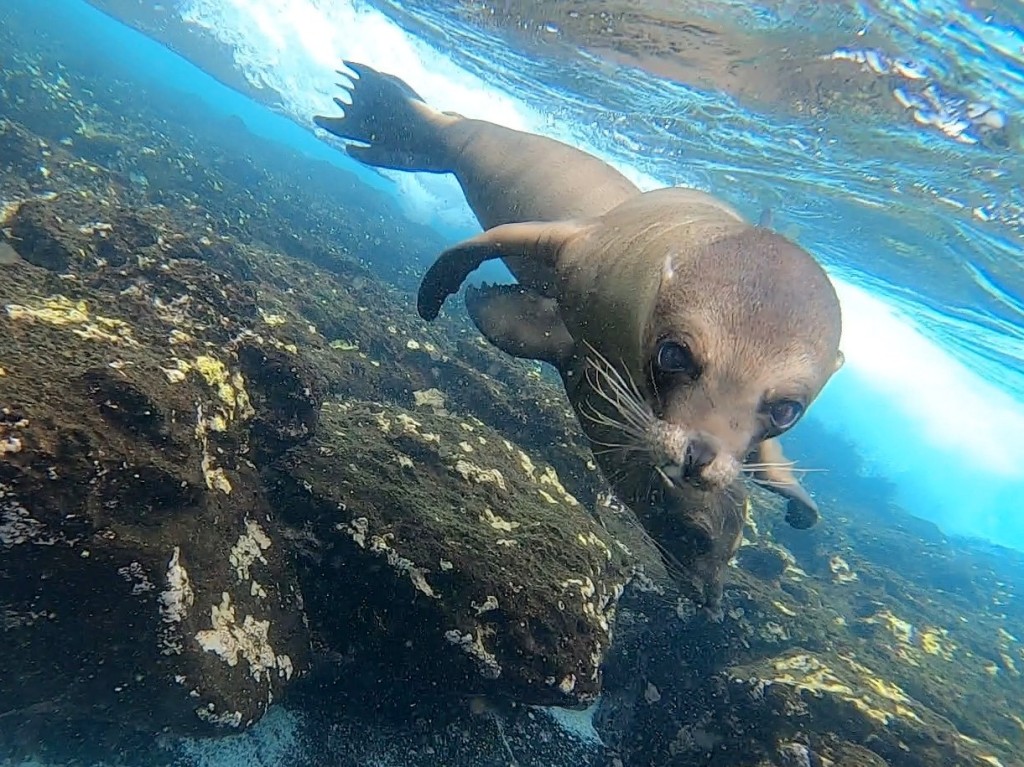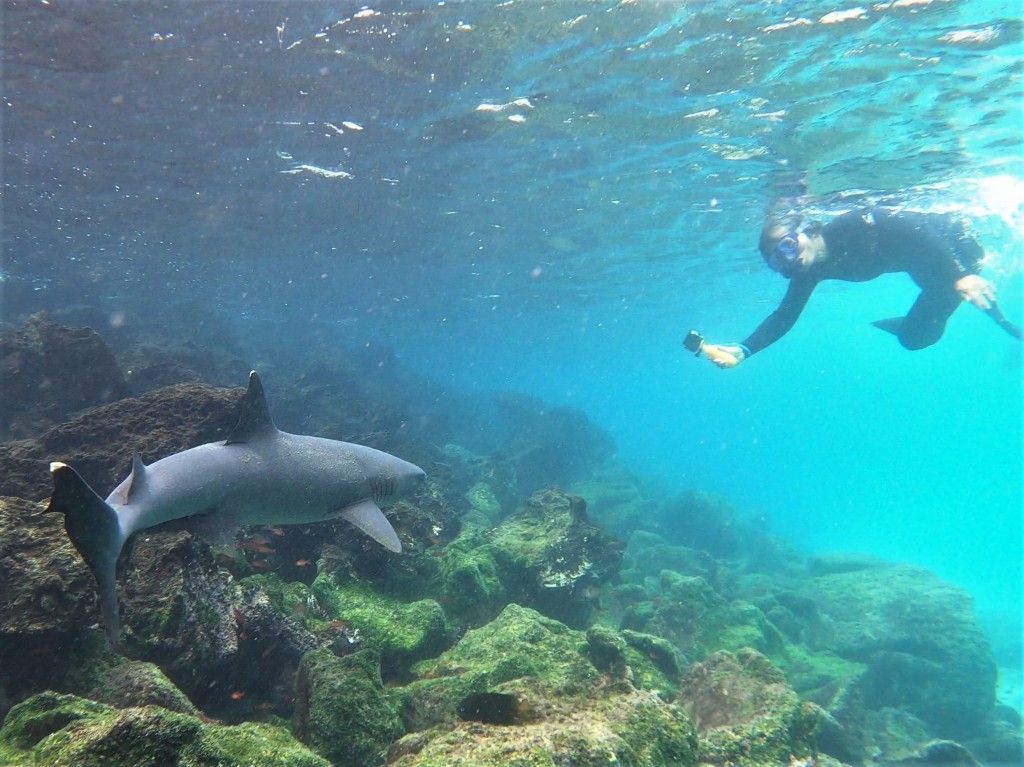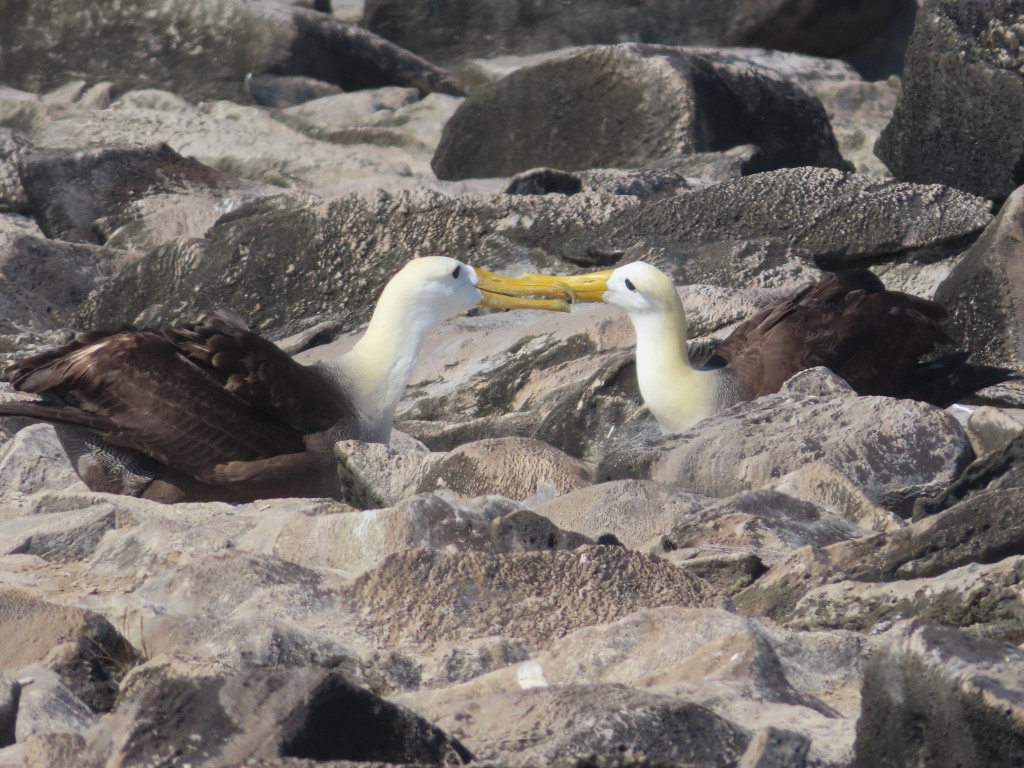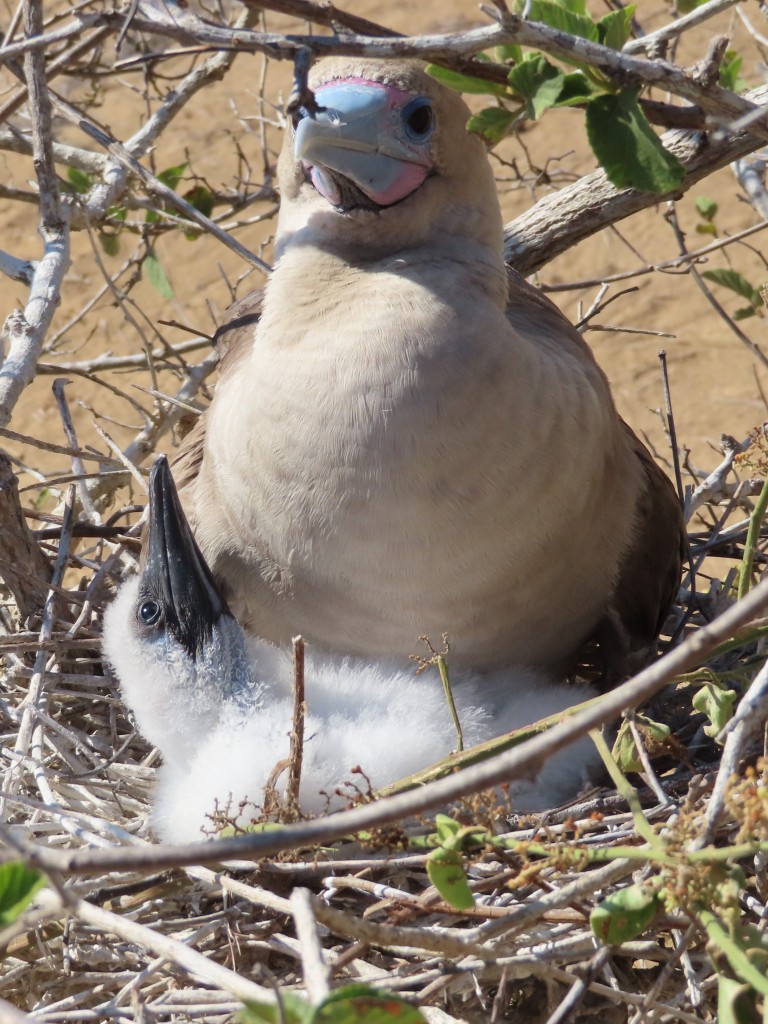I confess. I had thought the Galapagos would be kind of boring: big turtles and lots of birds on barren rock. Yawn.
I was thrilled to be utterly wrong wrong wrong.
Just a four-hour flight from Miami is a pristine, unique wildlife wonderland. The abundance of unusual, endemic (i.e. exists only here) critters–unafraid of humans–makes you gawk and smile. But I offer this caveat: you can enjoy a lot on land. But it’s underwater where the magic happens.

My daughter and I are active, independent travelers, and spent 19 wonderous nights in December: 7 in the Quito area (Mindo, Cotopaxi, Quilotoa), 3 on Isabela, 4 on Santa Cruz, and 4 on a La Pinta cruise.
Here are our highlights and suggestions.
RAVE HIGHLIGHTS
1. ISABELA: Snorkeling at Cabo Rosa, which is part of the famed Tuneles tour. We went twice: Darwin (!) with Padhoehoe was amazing. Within a small area, you will see gigantic sea turtles (dwarfing giant tortoises), sea lions, sharks, a sea horse (perhaps there’s only one as we saw him twice?), giant lobsters, and eagle rays.
- FYI we were given mixed info on whether you can snorkel at Tuneles (yes and no). We were intrigued at how the water and marine life changed so much on our two visits.
2. ISABELA: Concha de Perla: This is a magical pier with a small beach: sea lions galore, iguanas all about, turtles close to shore; even penguins swimming by.
3. ISABELA: Tintoreras kayak and snorkel with Carlos of Kayaking Isabela (the hut on the beach of Concha de Perla). He was incredibly nice, fun and engaged. While waiting for three young men to join us, he took many Christmas portraits of us with sea lions and in our kayak. When one of the three, going bare-chested, froze and got tired in the water, Carlos towed him to see sights including three huge lobsters he spotted under a cave; and a number of sharks (Tintoreras=species of shark!). We saw five penguins together on this trip.

4. FROM SANTA CRUZ: Meine Steffi yacht day trips with Guiding Galapagos: We went to Floreana and Pinzon on this beautiful boat, guided by enthusiastic, knowledgeable co-owner Yazmany on the second trip. Floreana included amazing sea lions frolicking all about and a beach where many turtles had recently laid eggs and were getting ready to go back to sea. At Pinzon, we had perfect weather and clear water for phenomenal photos. (We were tickled by Yazmany’s rapture as we tracked a marine iguana dining underwater.)
5. ABOARD LA PINTA: Many nice stops but the standouts were gorgeous Cerro Brujo beach at San Cristobal with lots of turtles and sea lions (but snorkeling not allowed); and Punta Suárez at Espanola with sea lions, cliffs, oodles of waved albatrosses; boobies with eggs and infants; hawks and, of course, iguanas.





6. ABOARD LA PINTA: Astonishing last night of the cruise around Gardner Bay at Espanola: After a mediocre kayak, five of us were in a panga back to the boat when someone spotted splashing way in distance: a ton of bottle-nosed dolphins. We spent nearly an hour surrounded by leaping playful dolphins as the sun set!!!
7. COTOPAXI: We made it to the glacier of the third highest active volcano in the world, about 90 minutes and 2 rugged hours south of Quito. On day four of our trip, we hiked from the parking lot to the refuge of Cotopaxi volcano: maybe the shortest tough hike we’ve ever done due to the altitude of 15,000. It took nearly an hour for nearly a mile. After a hot chocolate respite at the refuge, we went another 25 minutes to the edge of the glacier, about 16,730 feet. It was sleeting, cloudy and cold. But as we left the mountain came out in full glory, briefly.
- You may have to strong arm the guide to go to the glacier.
- There are no toilets at the parking lot, only at the refuge.
- It was tricky to pack for two different trips: cold hiking at Cotopaxi and Quilotoa plus water adventures in Galapagos. Tip: arrange to store unneeded gear at your airport hotel before going to the Galapagos, then retrieve before flying home.
RAVE PEOPLE/LODGINGS/MEALS
1. Campus Adventure Trekking was our local tour contact in Quito and they were awesome in responsiveness and assistance, especially when American Airlines lost our bags. At the last minute, Mery arranged to store bags for us at Quito Wyndham so we didn’t have to lug them to the Galapagos.
2. Francisco and Casa Joachim in Quito: This small boutique hotel in Mariscal was charming; its manager amazingly helpful.
3. Stephanie and Yazmany with Guiding Galapagos in Santa Cruz: terrific communication and information from Stephanie via Facebook. We started discussing a full tour package and ended up with two fabulous day tours on their lovely yacht.
4. Las Terrazas de Dana in Mindo: We stayed one night early in our trip, partly to acclimatize. David and Ana were wonderful; the lodge in the cloud forest delightful. David was very responsive and arranged efficient transfers and tours.
5. Best meals: Lunch at Hosteria Chukirawa in Quilotoa after hiking part of the rim: fresh lamb stew, chicken stew, plantains, veggies, large jug of narajilla juice (our favorite) and canelazo (sweet hot alcoholic drink) for $17.50! Dinner at Al Mar in Santa Cruz (at the end by the Darwin Center): delicious seafood risotto, lobster and drinks on the water with a view of town and sea (and our upcoming cruise ship La Pinta!). $74.70.
6. Best shopping: We loved the soft alpaca wool and negotiated at both the artisan hall in Quilotoa and the big craft market in Mariscal, not far from Casa Joachin. (Tip: you can get the big blankets for $15 with just a little haggling.)
COVID TRAVEL LOGISTICS
Our trip had been postponed twice due to COVID. Originally, we were doing both Peru (Machu Picchu) and Galapagos but decided to focus on Ecuador–where COVID incidences began peaking as we were ending our travels.
The State department website says as of April 25, travelers over 13 are required to have:
- A COVID-19 vaccination card
- A negative PRC COVID test taken no more than 72 hours prior to boarding the flight to Ecuador. (This is now nicely explicit.)
- A declaration of traveler health via Ministry of Public Health website. We did this online the day before but then American Airlines gave us a hard copy on the flight: one per family vs. one per person. They collected the hard copy upon arrival in Quito.
As of February, you do not need a special PCR test to get into the Galapagos from mainland Ecuador.
TRAVEL LOGISTICS
Ecuador is an ideal destination, especially from the East Coast, because it’s so close, it uses American dollars and American plugs and is on the same time zone! If you fly into Quito, be prepared for acclimatization at 10,000 feet!
First, the main question you have: can you do a land-based trip? Yes, if you’re a seasoned traveler. In hindsight, we could have added 3 nights at San Cristobal for day trips and skipped the pricey cruise. While La Pinta was a nice ship (great service; comfy rooms; best shower of our trip), we felt the group outings were not as fulfilling as our day tours, and not of the pace we prefer. So: you can fly into Baltra from the mainland, fly to Isabela for 2-3 nights, ferry to Santa Cruz for 2-3 nights; ferry to San Cristobal for 2-3 nights, ferry back to Santa Cruz and fly out from Baltra.
1. Money: Bring lots of cash in small bills. But ATMs were plentiful, including on the islands. Ecuador uses dollar coins, which will be disconcerting at first. We limited $100 bills as advised by others, but saw them used without problems including on Cotopaxi. Bring dimes for buying toilet paper in public restrooms.
2. Airports:
- Quito is surprisingly compact and easy to navigate. There is a line to screen your baggage before you check in; a kiosk to buy your Galapagos entry form ($100 each); counters for the main airlines.
- Galapagos Baltra: This main gateway into the islands is tiny, and accessible only via a bus, a ferry and a taxi/transfer. It’s not complicated and everyone else is in the same situation. They will load your bags onto each portion so don’t fret. (Many cruise ships will leave from the port near the airport so be prepared for a long transfer.)
- Galapagos Isabela: Really tiny. We flew with Emetebe after arriving at Baltra from Quito. They limit your baggage weight but you can buy extra kilos (a little cheaper online in advance). They piled our bags together to weigh them. We did not arrange for an airport pickup and had to wait about 15 minutes for a taxi (white pickup truck) to circle back to the airport. (Tip: pay extra to be picked up!)
3. Ferries/boats:
- December was supposed to be calmer seas but it was very rough. Gird yourself.
- Ferries between Isabela and Santa Cruz are in various-sized yacht/boats. We took the Regata, which looked like a cool James Bond yacht, but wasn’t so cool for nearly three hours jammed with 24 others. It’s smart to line up early so you can grab a preferred seat in the back facing forward (pack your personal items in waterproof gear), or one of the few seats above.
- You will likely take a variety of water taxis: they collect 50 cents or $1 per person.
- If on a cruise, you will take “pangas,” rubber rafts with a motor, to and from your boat. Often you will have “wet” landings meaning you have to step into water from the panga to get to the shore. Usually it’s up to your calves at most.
5. Water: Even though it’s near the Equator, it was very cold in December—60s. You definitely want wetsuits, which are included in most tours. For the best protection in the water, it should feel uncomfortably tight when you try it on. If you are concerned about getting in the water, the good news is the water is buoyant and your wet suit will help you stay even more afloat. Plus most top snorkeling sites are fairly shallow and the guides are great about helping if needed.
6. Weather: It had been pouring for weeks before we arrived. It was mostly cloudy with sun breaks during our stay until our last five days when it was beautifully sunny.
7. Language: While Ecuadorians are accustomed to tourists, many contacts will have limited English. It’s worthwhile to pick up some key Spanish phrases and have a translation app. I had not used whatsapp before but it was efficient and vital for this trip.
Click here for our photo album!
Enjoy!

